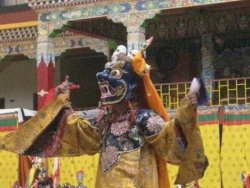Yama, Lord of Death
He is the main character in a majority of cham dances. His story is the strong stuff of good folklore.
“Originally he was a monk who believed that if he went into seclusion and deep meditation for fifty years he would attain enlightenment. He was in the final hour of the final day of his 50-year long meditation when two rustlers came into his cave late at night with a stolen bull. Thinking they were alone, they proceeded to cut off the bull’s head. When they realized that the hermit monk has seen them, they threatened to kill him too. The monk begged for mercy, explaining that all his efforts over almost fifty years to attain enlightenment, which would happen in a few short minutes, would be lost if they took his life. Unmoved, the rustlers cut off the monk’s head as well.
The monk, so close to enlightenment and yet robbed of it, was angered beyond belief and he felt around for his head to put it back on. Being unable to see, he mistakenly grabbed the bull’s head and placed it firmly back on his shoulders. He then vented his anger, killed the two interlopers, made cups from their skulls, drank their blood and ate their flesh and organs. The monk now had the bull’s head. Yama, the God of Death, was born.”
Yama was of course very angry that he had been denied his enlightenment, although some say that, in spite of this, he quite enjoyed his new look. He was also very pleased and satisfied with killing the two robbers, drinking their blood and eating their vital organs. In fact, he liked it! And so he continued killing people and was soon on a murderous rampage throughout Tibet. The people were very afraid and asked for assistance. Eventually Yama was soundly defeated and turned into a protector deity, a sworn defender of the faith. He has since become one of the main and most important Cham dancers.
